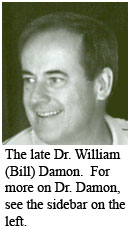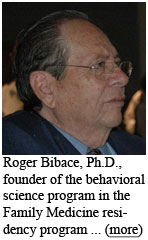Family Medicine Comes to Massachusetts (cont'd.)
The effort to forge a distinctive culture for family doctors in fact grew out of the core beliefs of the specialty. As Stephens wrote in 1981, the family practitioner is "committed to helping patients understand their illnesses in the light of their personal and family histories … This indeed requires knowing the patients' names and the experiences, memories and feelings these names stand for." In other words, he continued, "What is required is a therapeutic relationship between patient and doctor that is not only concerned with taking the patient's history, but which allows both to meet as real persons, re-enacting various aspects of their personal identities in the hope of healing."(52)
 How can such an acute capacity for self awareness and empathy be developed? One approach encouraged by Family Practice residencies
depended on an explicit curriculum in the behavioral sciences, especially psychology, sociology, and anthropology. But perhaps the more
distinctive aspect of Family Medicine curricula addressed the development of residents' psychological, rather than intellectual, growth.
At the University of Massachusetts Medical School, as at approximately 60 other programs, a technique known as the Balint group was, and
still is, a mainstay of personal development for both residents and faculty.(53)
How can such an acute capacity for self awareness and empathy be developed? One approach encouraged by Family Practice residencies
depended on an explicit curriculum in the behavioral sciences, especially psychology, sociology, and anthropology. But perhaps the more
distinctive aspect of Family Medicine curricula addressed the development of residents' psychological, rather than intellectual, growth.
At the University of Massachusetts Medical School, as at approximately 60 other programs, a technique known as the Balint group was, and
still is, a mainstay of personal development for both residents and faculty.(53)
Balint groups, named for their creator, the Hungarian-born, British psychiatrist Michael Balint, consist of a group of professional peers, ideally fewer than 12 per group, who meet to confidentially discuss cases which are being experienced as "difficult." The difficulty is not primarily medical, but rather psychological: a patient, perhaps, who makes the doctor feel inadequate, or who never accepts medical advice, or whose family undermines the treatment, or who triggers inappropriate sexual feelings. Any of these or a host of other interpersonal dilemmas can trigger a physician's desire to bring the case to the group. Typically, after the case is presented, with careful prompting from a Balint group leader, the rest of the group discusses how the account they have just heard makes them feel and what they might do in that situation. Toward the end of the discussion, the presenter will re-enter the conversation, adding details he or she overlooked at the outset, and confirming or rejecting the intuitive reactions voiced earlier by the other group members. At its best, a Balint group can help a physician re-frame a case in light of a deeper understanding of the physician him/herself as well as new insights into the patient.(54) Stephens had learned about Balint in 1970 and incorporated Balint groups into his program at Wichita. From his experience consulting in Worcester in 1974 he recalled:
The emphasis on the doctor-patient relationship was one of the new features about family practice education. Basically doctors don't know much about what other doctors say to their patients. We get a lot of word of mouth but we don't get it in words. You know, the doctor told me I only have 6 months to live. Well, that may or may not be true. If you ask the doctor, you might get a different impression. So this was one of the truly new topics for medical education that we took very seriously and I think Worcester was the place where this got implemented and pursued with intensity and durability perhaps more than any other place. And Roger Bibace is probably the guy that held that together. Roger played a unique role.(55)
 In the Worcester program, three Balint groups were in operation by 1980, one each for residents at the Worcester and Fitchburg
programs, and one for faculty. Dr. Roger Bibace, a psychologist practicing at Clark University whom John Frey brought into the
program to direct its Behavioral Science component, co-led the faculty Balint group which continues to the present day. (Joseph
Mendola was his counterpart at Fitchburg from 1979 on, while William Damon, M.D., ran a group for residents.)(56)
Bibace described some of the traditions of the Worcester faculty Balint group:
In the Worcester program, three Balint groups were in operation by 1980, one each for residents at the Worcester and Fitchburg
programs, and one for faculty. Dr. Roger Bibace, a psychologist practicing at Clark University whom John Frey brought into the
program to direct its Behavioral Science component, co-led the faculty Balint group which continues to the present day. (Joseph
Mendola was his counterpart at Fitchburg from 1979 on, while William Damon, M.D., ran a group for residents.)(56)
Bibace described some of the traditions of the Worcester faculty Balint group:
One of the rules of the early Balint group was we also don't…want to deal with the hassles of your particular family health center in terms of its administrative stuff. Here we're dealing with doctor-patient relationships, and a lot of the time, with faculty-resident relationships. And eventually it became…you as a person and your family, not just your relationships to patients, but you and your family. So people talked about births, deaths, marriages, big events, like my father died, my child, and so on and so forth, and so "family" began to include your own personal family. And how are you going to deal with your father who is growing old and senile…and he's out in California, but the family is calling you and saying well, you know, you're the doctor, what should we do…parallels between what's going on in my patient's life and what's going on in my own life.(57)
In short order, Balint groups became an important component in the bonding of the early cohort at the Family Medicine program in Worcester. For example, John Frey, first Family Medicine residency director, learned about Balint before he arrived here. One of his first recruits, Lucy Candib, had already read Balint's book, The Doctor, His Patient, and the Illness, long before she interviewed with Frey for a slot as a second year resident in 1974. At her residency interview with John Frey, she remembers:
We spent an hour talking about Balint, and as a result of that, and also my conversation with Dick Walton, who was the then chair of Family Medicine, they wanted me to be a second-year resident, and I wanted to be one very badly. So I came out to Worcester the following July and started as a second-year resident when the residency opened. July of '74 when they accepted their first interns, I was a second-year resident, and they were very pleased to have me and I was very pleased to be here.(58)

